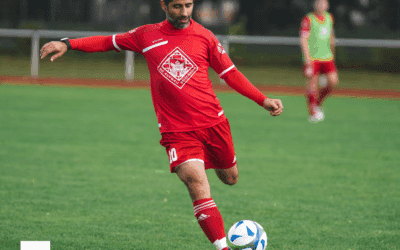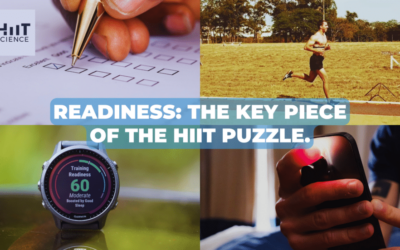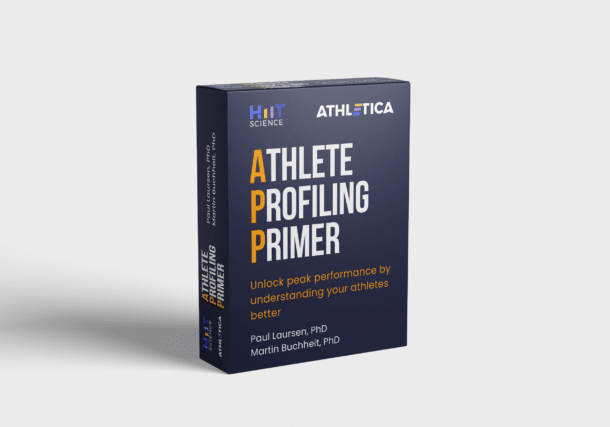I’ve been wanting to write this post for some time. I love our field of applied sport science. Having been part of it for some time now, one thing I’ve noticed is how many of us stem from a solid background in sport – one where we never quite reached the top. My buddy,
Dan Plews, likes to refer to guys like this, like me, as your stock standard Will Ferrell ‘
semi-pro’.
That was certainly the case for me. Like many of us, I was fascinated by sport growing up. I watched and played every sport I could. As an all-rounder, triathlon became the sport that caught my attention and where I achieved some success just as the sport was gaining popularity in the 1990’s. While I was a capable triathlete, I was nowhere good enough. Dedicating myself to the sport, I literally reached what was called in those days, the ‘semi-pro’ status, gaining minor sponsors, training during the day, and waiting tables in the evening to make ends meet. That is where the dream of representing in the sport would end for me. As it turns out, from the other side of the world, Martin was following a similar path. He too was fascinated by sport, playing a bit of everything – but it was handball that really caught his interest. He too reached the ‘semi-pro’ status, and no further.

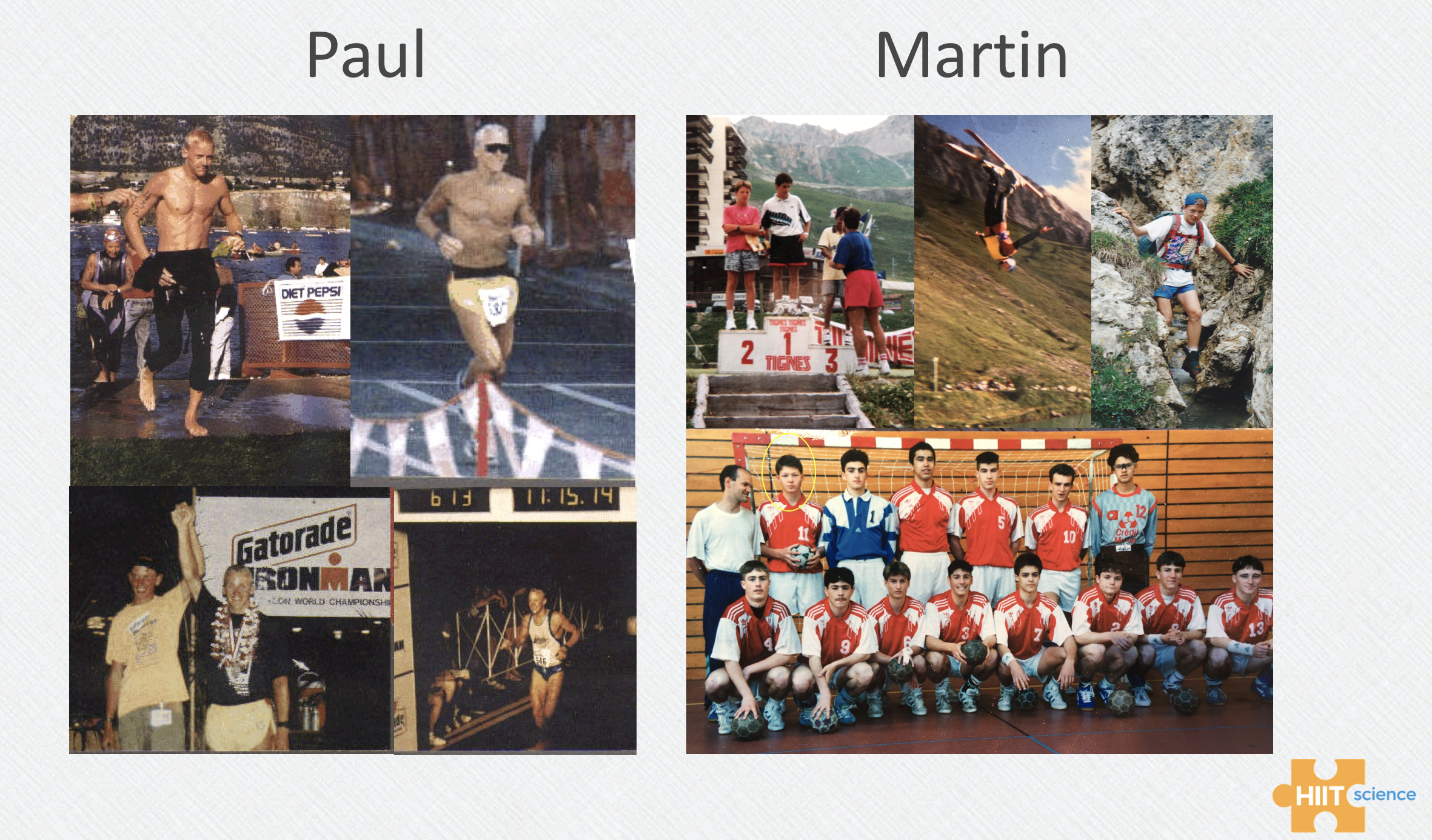
Our love for sport embedded a passion and a dream within each of us. With the dream came expectations. But when our passions reached a crossroads with our relative lack of talent, a degree of disappointment was inevitable. As Mo Gawdat explains in “
Solve for Happy” (4), a temporary state of unhappiness arose.
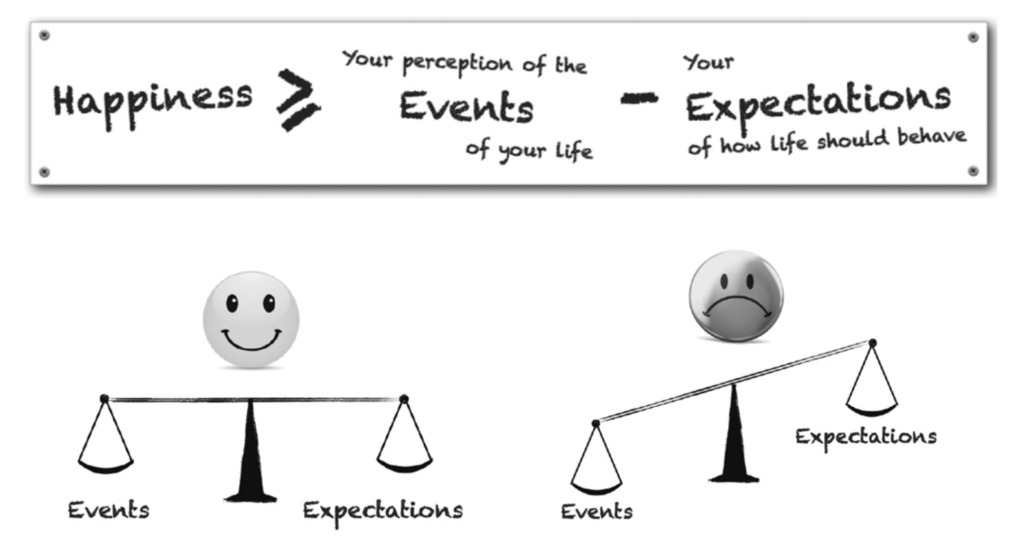
So, if a career as a professional athlete isn’t in the cards, what’s left for one to do? The answer, of course, become a sport scientist!
I can remember entering into the field of study in the mid-1990s. It was tiny. Many warned me that finding a job after I graduated was going to be tough. But I didn’t care – I knew what I wanted to do. If I couldn’t figure out my own performance I was at least going to study it, figure out why I couldn’t reach the next level, and aim to help others from the experience. Martin’s trajectory was similar, and if you’re reading this, perhaps you too can relate. The passion was still there – it just needed to be redirected.
This reminded me of a story told to me by the author of our cycling chapter in HIIT Science,
Marc Quod, back when he was a postgraduate student in the Australian Institute of Sport (AIS) system. Quody, as he’s affectionately known, was visiting me in Perth for some slow thinking time away from the demands of the Aussie cycling program (3). I always valued Quody’s visits, as each time I would gain substantial insight into life in the trenches of high-performance sport, the world beyond the life of a semi-pro, and its real world pressures and
contexts that I, an academic, needed to appreciate better. Additionally, I would get to hear the latest and greatest thinking that was coming out of the AIS’s “ideas meetings”; an initiative of
Allan Hann’s AIS physiology department since well before my time.
On this particular visit, Marc described a presentation he attended by the legendary (to us at least) Senior Physiologist
Dr David T. Martin. Here, DTM was sharing his observations of relationships between coaches, sport scientists and athletes, where frustrations sometimes arise, where time should (or shouldn’t) be spent, and how different ideas/processes might be implemented with each group. While the original slide is lost from our records, the general gist of the figure is shown here.
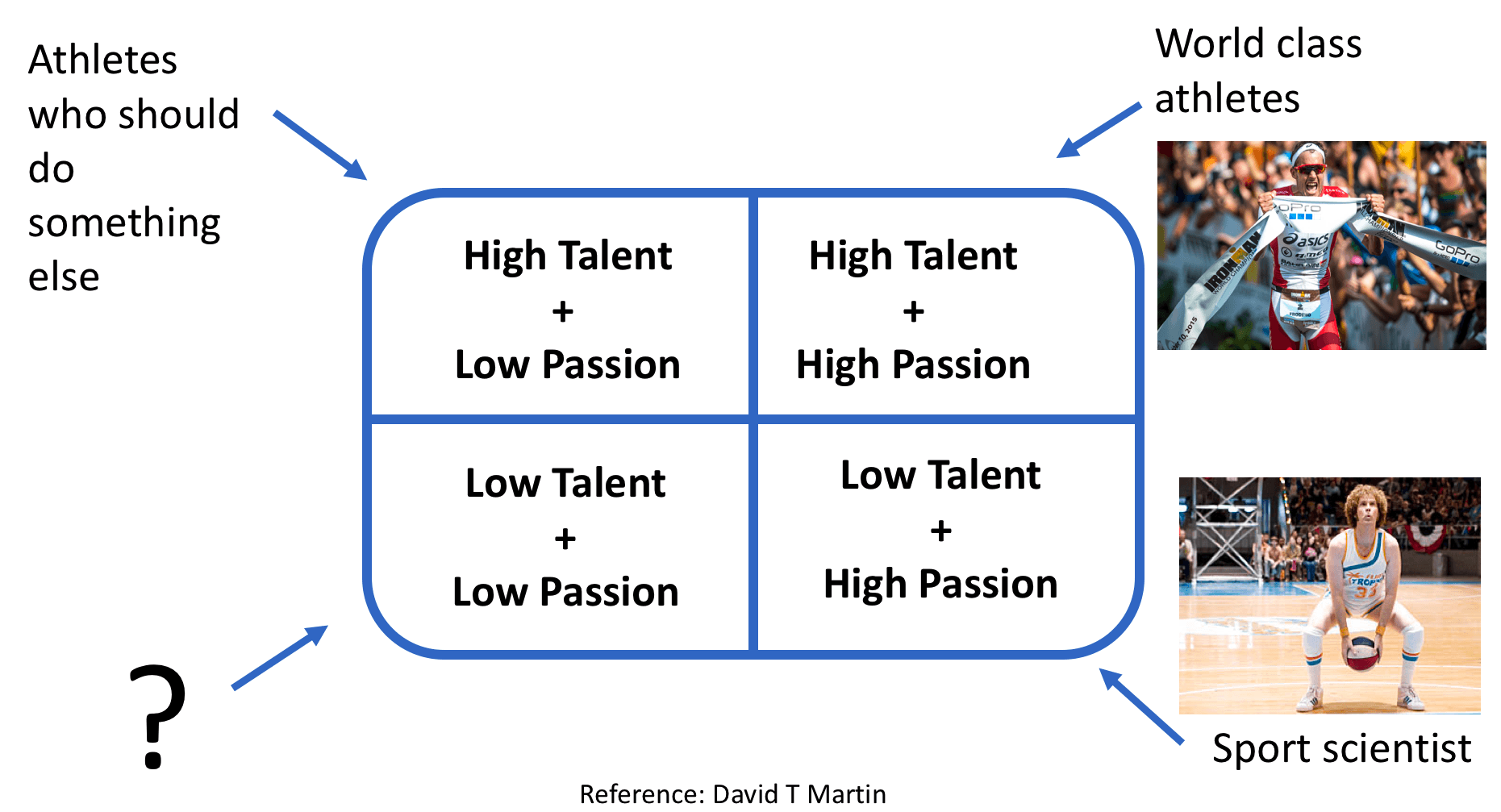
Of course, this is an oversimplification of the importance of having both talent and passion for success in the high-performance setting but there are some recurring patterns in the other quadrants that we’ve observed over time. Marc kindly shares his memory for us here:
“For the high talent / low passion quadrant (upper left), these athletes were referred to as the “frustrating” athletes. If only you could get them to do 50% of the work, they would be great! But to be fair, athletes in the low talent/high passion quadrant (lower right, semi-pros) were also considered “frustrating” by the high talent / low passion group”.
That lower right group, the semi-pros like Martin and me, often can become great sport scientists, however. While this was the running joke of the meeting with DTM, I contend that it’s one filled with truth. Which leads me to the last point I want to make concerning our role as sport scientists today and where our contributions can be considered of value.
In Jace Delaney’s last
post he reminds us clearly of where we sit in the pecking order of the high-performance culture. He states that “teams with the best players typically win, regardless of which GPS provider the team decides to sign with or which pre-season testing protocol was used in the first week of training”. Put another way, innate talent is the biggest player. But where I believe we can make an impact in the context of high-performance sport is described well by Ross Tucker and Malcolm Collins (5), where they show the theoretical relationship between talent (innate ability), training preparation, and performance. Note here how the athletes (individual’s A-F) all have a level of innate ability, described by the size of the rectangle. We semi-pro sport scientists are shown as individual E – no chance of making the elite performance level. But those high-level athletes we work with, with great levels of talent (individuals A-D), can be affected through proper training. So much so that in this example, athlete C with less talent wins over the more talented athlete B, because she prepared near her potential (5).

Herein lies the essence of what we’re trying to do with HIIT Science. Our aim is to teach the science and application of HIIT, so that your talented athletes stand a better chance of succeeding on the world stage. If we understand the science, use our semi-pro backgrounds to help us appreciate our
sport context, we can (
pragmatically),
think outside the box (2), ask the right questions, and apply the science to contribute towards a very likely, substantial,
0.2 (1).
Semi-pros unite!
References
- Buchheit M. Chasing the 0.2. Int J Sports Physiol Perform 11: 417-418, 2016.
- Buchheit M. Outside the Box. Int J Sports Physiol Perform 12: 1001-1002, 2017.
- Coutts AJ. Working Fast and Working Slow: The Benefits of Embedding Research in High Performance Sport. Int J Sports Physiol Perform 11: 1-2, 2016.
- Gawdat M. Solve for Happy: Engineer Your Path to Joy. Basingstoke, United Kingdom: Pan Macmillan, 2017.
- Tucker R and Collins M. What makes champions? A review of the relative contribution of genes and training to sporting success. Br J Sports Med 46: 555-561, 2012.

 Our love for sport embedded a passion and a dream within each of us. With the dream came expectations. But when our passions reached a crossroads with our relative lack of talent, a degree of disappointment was inevitable. As Mo Gawdat explains in “Solve for Happy” (4), a temporary state of unhappiness arose.
Our love for sport embedded a passion and a dream within each of us. With the dream came expectations. But when our passions reached a crossroads with our relative lack of talent, a degree of disappointment was inevitable. As Mo Gawdat explains in “Solve for Happy” (4), a temporary state of unhappiness arose.
 So, if a career as a professional athlete isn’t in the cards, what’s left for one to do? The answer, of course, become a sport scientist!
I can remember entering into the field of study in the mid-1990s. It was tiny. Many warned me that finding a job after I graduated was going to be tough. But I didn’t care – I knew what I wanted to do. If I couldn’t figure out my own performance I was at least going to study it, figure out why I couldn’t reach the next level, and aim to help others from the experience. Martin’s trajectory was similar, and if you’re reading this, perhaps you too can relate. The passion was still there – it just needed to be redirected.
This reminded me of a story told to me by the author of our cycling chapter in HIIT Science, Marc Quod, back when he was a postgraduate student in the Australian Institute of Sport (AIS) system. Quody, as he’s affectionately known, was visiting me in Perth for some slow thinking time away from the demands of the Aussie cycling program (3). I always valued Quody’s visits, as each time I would gain substantial insight into life in the trenches of high-performance sport, the world beyond the life of a semi-pro, and its real world pressures and contexts that I, an academic, needed to appreciate better. Additionally, I would get to hear the latest and greatest thinking that was coming out of the AIS’s “ideas meetings”; an initiative of Allan Hann’s AIS physiology department since well before my time.
On this particular visit, Marc described a presentation he attended by the legendary (to us at least) Senior Physiologist Dr David T. Martin. Here, DTM was sharing his observations of relationships between coaches, sport scientists and athletes, where frustrations sometimes arise, where time should (or shouldn’t) be spent, and how different ideas/processes might be implemented with each group. While the original slide is lost from our records, the general gist of the figure is shown here.
So, if a career as a professional athlete isn’t in the cards, what’s left for one to do? The answer, of course, become a sport scientist!
I can remember entering into the field of study in the mid-1990s. It was tiny. Many warned me that finding a job after I graduated was going to be tough. But I didn’t care – I knew what I wanted to do. If I couldn’t figure out my own performance I was at least going to study it, figure out why I couldn’t reach the next level, and aim to help others from the experience. Martin’s trajectory was similar, and if you’re reading this, perhaps you too can relate. The passion was still there – it just needed to be redirected.
This reminded me of a story told to me by the author of our cycling chapter in HIIT Science, Marc Quod, back when he was a postgraduate student in the Australian Institute of Sport (AIS) system. Quody, as he’s affectionately known, was visiting me in Perth for some slow thinking time away from the demands of the Aussie cycling program (3). I always valued Quody’s visits, as each time I would gain substantial insight into life in the trenches of high-performance sport, the world beyond the life of a semi-pro, and its real world pressures and contexts that I, an academic, needed to appreciate better. Additionally, I would get to hear the latest and greatest thinking that was coming out of the AIS’s “ideas meetings”; an initiative of Allan Hann’s AIS physiology department since well before my time.
On this particular visit, Marc described a presentation he attended by the legendary (to us at least) Senior Physiologist Dr David T. Martin. Here, DTM was sharing his observations of relationships between coaches, sport scientists and athletes, where frustrations sometimes arise, where time should (or shouldn’t) be spent, and how different ideas/processes might be implemented with each group. While the original slide is lost from our records, the general gist of the figure is shown here.
 Of course, this is an oversimplification of the importance of having both talent and passion for success in the high-performance setting but there are some recurring patterns in the other quadrants that we’ve observed over time. Marc kindly shares his memory for us here:
“For the high talent / low passion quadrant (upper left), these athletes were referred to as the “frustrating” athletes. If only you could get them to do 50% of the work, they would be great! But to be fair, athletes in the low talent/high passion quadrant (lower right, semi-pros) were also considered “frustrating” by the high talent / low passion group”.
That lower right group, the semi-pros like Martin and me, often can become great sport scientists, however. While this was the running joke of the meeting with DTM, I contend that it’s one filled with truth. Which leads me to the last point I want to make concerning our role as sport scientists today and where our contributions can be considered of value.
In Jace Delaney’s last post he reminds us clearly of where we sit in the pecking order of the high-performance culture. He states that “teams with the best players typically win, regardless of which GPS provider the team decides to sign with or which pre-season testing protocol was used in the first week of training”. Put another way, innate talent is the biggest player. But where I believe we can make an impact in the context of high-performance sport is described well by Ross Tucker and Malcolm Collins (5), where they show the theoretical relationship between talent (innate ability), training preparation, and performance. Note here how the athletes (individual’s A-F) all have a level of innate ability, described by the size of the rectangle. We semi-pro sport scientists are shown as individual E – no chance of making the elite performance level. But those high-level athletes we work with, with great levels of talent (individuals A-D), can be affected through proper training. So much so that in this example, athlete C with less talent wins over the more talented athlete B, because she prepared near her potential (5).
Of course, this is an oversimplification of the importance of having both talent and passion for success in the high-performance setting but there are some recurring patterns in the other quadrants that we’ve observed over time. Marc kindly shares his memory for us here:
“For the high talent / low passion quadrant (upper left), these athletes were referred to as the “frustrating” athletes. If only you could get them to do 50% of the work, they would be great! But to be fair, athletes in the low talent/high passion quadrant (lower right, semi-pros) were also considered “frustrating” by the high talent / low passion group”.
That lower right group, the semi-pros like Martin and me, often can become great sport scientists, however. While this was the running joke of the meeting with DTM, I contend that it’s one filled with truth. Which leads me to the last point I want to make concerning our role as sport scientists today and where our contributions can be considered of value.
In Jace Delaney’s last post he reminds us clearly of where we sit in the pecking order of the high-performance culture. He states that “teams with the best players typically win, regardless of which GPS provider the team decides to sign with or which pre-season testing protocol was used in the first week of training”. Put another way, innate talent is the biggest player. But where I believe we can make an impact in the context of high-performance sport is described well by Ross Tucker and Malcolm Collins (5), where they show the theoretical relationship between talent (innate ability), training preparation, and performance. Note here how the athletes (individual’s A-F) all have a level of innate ability, described by the size of the rectangle. We semi-pro sport scientists are shown as individual E – no chance of making the elite performance level. But those high-level athletes we work with, with great levels of talent (individuals A-D), can be affected through proper training. So much so that in this example, athlete C with less talent wins over the more talented athlete B, because she prepared near her potential (5).
 Herein lies the essence of what we’re trying to do with HIIT Science. Our aim is to teach the science and application of HIIT, so that your talented athletes stand a better chance of succeeding on the world stage. If we understand the science, use our semi-pro backgrounds to help us appreciate our sport context, we can (pragmatically), think outside the box (2), ask the right questions, and apply the science to contribute towards a very likely, substantial, 0.2 (1).
Semi-pros unite!
References
Herein lies the essence of what we’re trying to do with HIIT Science. Our aim is to teach the science and application of HIIT, so that your talented athletes stand a better chance of succeeding on the world stage. If we understand the science, use our semi-pro backgrounds to help us appreciate our sport context, we can (pragmatically), think outside the box (2), ask the right questions, and apply the science to contribute towards a very likely, substantial, 0.2 (1).
Semi-pros unite!
References


